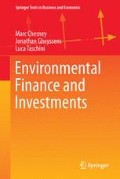Abstract
According to the Intergovernmental Panel on Climate Change (IPCC) which aggregates international research efforts on climate change, global atmospheric concentrations of greenhouse gases (CO2, CH4 and N2O) have increased markedly as a results of human activities since 1750. As their concentrations in the atmosphere intensify, GHG act as a radiation trap that forces more energy to stay on surface and more heat to be produced, therefore causing global warming. According to the sensitivity projections of the IPCC, any commitment to limit the global average temperature increase within a +2 °C limit would force to stabilize CO2 concentration around 350–400 ppm. However, until damages are elicited and adaptation cost monetized, the urgency of taking measure against global warming remains for many elusive. This chapter will present the two clearest possible strategies to limit the causes of climate change and its impact, mitigation and adaptation strategies and details their respective strengths and weaknesses. We show that to be effective, an a optimal policy against climate changes and their impacts will have to combine both mitigation and adaptation. While adaptation are easier to implement, bear less uncertainties and can be privatized (partially avoiding free-riding effects), mitigation strategies are the only capable to reduce GHGs in the atmosphere in order to reestablish a viable long-term CO2 concentration.
Access this chapter
Tax calculation will be finalised at checkout
Purchases are for personal use only
Notes
- 1.
The recognized GHG are carbon dioxide CO2, methane CH4, nitrous oxide N2O, hydrofluorocarbons HFC, perfluorocarbons PFC and sulfur hexafluoride SF6. Despite its influence on climate due to its ability to absorb infrared radiation, water vapor is not listed among the GHG gases.
- 2.
Source: NOAA.gov.
- 3.
- 4.
On November 19th 2009, the email server of the Climate Research Unit at the University of East Anglia (one of the most prominent research outlet on the issue of climate change) was hacked and email correspondences among its researchers were publicly disseminated. Dubbed “Climategate” by the press, the incident has revealed the bitter acrimony between climate change proponents and opponents and forced additional statements to reaffirm the existence of uncertainty in scientific evidence and results.
- 5.
Special Report on Emissions Scenarios (SRES).
- 6.
by shifting the time horizon from 2100 to 2090–2099 and changing the method for the inclusion of uncertainties.
- 7.
Source: Global Carbon Project, Carbon Budget 2010.
- 8.
Carbon intensity is the amount of carbon (in terms of weight) emitted per unit of energy consumed.
- 9.
These simulations are to be amended for the fifth Assessment Report which will be issued in 2013 (for the Physical Science Basis) and 2014 (for the Impacts, Adaptation and Vulnerability and the Mitigation of Climate Change reports).
- 10.
Carbon dioxide equivalency is a quantity that describes, for a given mixture and amount of greenhouse gas, the amount of CO2 that would have the same global warming potential. It is measured over a specified timescale, generally, 100 years.
- 11.
Among other attempts to define mitigation strategies and abatement supply curves, the International Energy Agency (IEA) regularly publishes the Energy Technology Perspective Reports that include a detailed roadmap for energy technology, from both the supply and the demand sides. Worth also noting but limited to the supply side, the consultancy McKinsey has computed an often-used abatement cost curve that includes all technologies available for less than the carbon permit’s price limit of the first EU ETS phase. (A cost curve for greenhouse gas reduction, McKinsey Quarterly, 2007.)
- 12.
References
IPCC (2007). Climate change 2007: synthesis report. Cambridge: Cambridge University Press.
Lecocq, F., & Shalizi, Z. (2007). Balancing expenditures on mitigation of and adaptation to climate change: an exploration of issues relevant to developing countries. Policy research working paper series 4299, The World Bank, Washington, DC.
Margulis, S., & Narain, U. (2009). The costs to developing countries of adapting to climate change: new methods and estimates. Global report of the economics of adaptation to climate change study, The World Bank, Washington, DC.
Mendelsohn, R., Morrison, W., Schlesinger, M., & Andronova, N. (1998). Country-specific market impacts of climate change. Climatic Change, 45(3–4), 553–569.
Nordhaus, W., & Boyer, J. (2000). Warming the world: economic models of global warming. Cambridge: MIT Press.
Pearce, D., Cline, W., Achanta, A., Fankhauser, S., Pachauri, R., Tol, R., & Vellinga, P. (1996). The social costs of climate changegreenhouse damage and the benefits of control. In Economic and social dimensions—contribution of working group III to the second assessment report of the intergovernmental panel on climate change. Climate change 1995 (pp. 179–224). Cambridge: Cambridge University Press.
Tol, R. (1999). The marginal damage costs of greenhouse gas emissions. The Energy Journal, 20(1), 61–81.
Tol, R. (2002). Estimates of the damage costs of climate change. Part I: benchmark estimates. Environmental & Resource Economics, 21(1), 47–73.
Tol, R. S. (2005b). The marginal damage costs of carbon dioxide emissions: an assessment of the uncertainties. Energy Policy, 33(16), 2064–2074. http://www.sciencedirect.com/science/article/pii/S0301421504001028.
Author information
Authors and Affiliations
Rights and permissions
Copyright information
© 2013 Springer-Verlag Berlin Heidelberg
About this chapter
Cite this chapter
Chesney, M., Gheyssens, J., Taschini, L. (2013). The Issue of Climate Change. In: Environmental Finance and Investments. Springer Texts in Business and Economics. Springer, Berlin, Heidelberg. https://doi.org/10.1007/978-3-642-36623-9_2
Download citation
DOI: https://doi.org/10.1007/978-3-642-36623-9_2
Publisher Name: Springer, Berlin, Heidelberg
Print ISBN: 978-3-642-36622-2
Online ISBN: 978-3-642-36623-9
eBook Packages: Business and EconomicsEconomics and Finance (R0)

